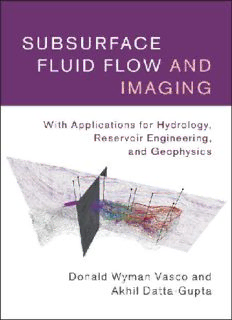Table Of ContentSUBSURFACE FLUID FLOW AND IMAGING
Thepracticeofimaginghasgrowntremendouslyoverthepastfewdecades.Atthe
sametime,understandingfluidflowatdepthhasbecomeincreasinglyimportantto
activitiessuchashydrocarbonproduction,groundwaterexploitation,environmen-
talremediation,andsequestrationofgreenhousegases.
Thisbookintroducesmethodologiesforsubsurfaceimagingbaseduponasymp-
totic and trajectory-based methods for modeling fluid flow, transport, and defor-
mation.Itdescribestrajectory-basedimagingandinversionfromitsmathematical
formulation, through the construction and solution of the imaging equations, to
the assessment of the accuracy and resolution associated with the image. Unique
in its approach, it provides a unified framework for the complete spectrum of
physical phenomena from wave-like hyperbolic problems to diffusive parabolic
problems and non-linear problems of mixed character. The practical aspects of
imaging, particularly efficient and robust methods for updating high resolution
geologic models using fluid flow, transport, and geophysical data, are emphasized
throughoutthebook.
Completewithonlinesoftwareapplicationsandexamplesthatenablereadersto
gainhands-onexperience,thisvolumeisaninvaluableresourceforgraduate-level
courses,aswellasforacademicresearchersandindustrypractitionersinthefields
ofgeoscience,hydrology,andpetroleumandenvironmentalengineering.
donald wyman vasco is a Senior Scientist at the Lawrence Berkeley
National Laboratory, recognized for his contributions to the development and
application of asymptotic techniques to the modeling and inversion of fluid flow
and geophysical data. Dr. Vasco is the recipient of the Society of Petroleum
Engineers’CedricK.FergusonCertificateforthebestpeer-reviewedpaperof1999,
and has authored or co-authored over 100 peer-reviewed articles on geophysical
andhydrologicalinversemethodsandmodelingtechniques.
akhil datta-gupta is Regents and University Distinguished Professor at
TexasA&MUniversity,andisknownforhiscontributionstothetheoryandprac-
ticeofstreamlinesimulationinpetroleumreservoircharacterization,management
and calibration of high-resolution geologic models. Professor Datta-Gupta is the
recipientoftheSocietyofPetroleumEngineers’JohnFranklinCarllAward(2009)
and Lester C. Uren Award (2003) for his contributions related to reservoir char-
acterization and 3-D streamline simulation. He served as a member of the Polar
Research Board of the National Academy of Sciences, Technology Task Force of
the National Petroleum Council and was elected to the US National Academy of
Engineeringin2012.
SUBSURFACE FLUID FLOW
AND IMAGING
With Applications for Hydrology, Reservoir
Engineering, and Geophysics
DONALD WYMAN VASCO AND AKHIL DATTA-GUPTA
UniversityPrintingHouse,CambridgeCB28BS,UnitedKingdom
CambridgeUniversityPressispartoftheUniversityofCambridge.
ItfurtherstheUniversity’smissionbydisseminatingknowledgeinthepursuitof
education,learningandresearchatthehighestinternationallevelsofexcellence.
www.cambridge.org
Informationonthistitle:www.cambridge.org/9780521516334
©DonaldWymanVascoandAkhilDatta-Gupta2016
Thispublicationisincopyright.Subjecttostatutoryexception
andtotheprovisionsofrelevantcollectivelicensingagreements,
noreproductionofanypartmaytakeplacewithoutthewritten
permissionofCambridgeUniversityPress.
Firstpublished2016
PrintedintheUnitedKingdombyTJInternationalLtd.PadstowCornwall
AcataloguerecordforthispublicationisavailablefromtheBritishLibrary
LibraryofCongressCataloguinginPublicationdata
Names:Vasco,DonaldWyman,author.|Datta-Gupta,Akhil,1960–author.
Title:Subsurfacefluidflowandimaging:withapplicationsforhydrology,
reservoirengineering,andgeophysics/DonaldWymanVascoandAkhilDatta-Gupta.
Description:NewYork,NY:CambridgeUniversityPress,2016.
|©2016|Includesbibliographicalreferencesandindex.
Identifiers:LCCN2015037883|ISBN9780521516334(Hardback:alk.paper)|
ISBN0521516331(Hardback:alk.paper)
Subjects:LCSH:Fluiddynamics–Mathematicalmodels.|
Groundwaterflow–Mathematicalmodels.|Hydrology.|
Petroleumengineering.|Geophysics.
Classification:LCCQC809.F5V372016|DDC551.49–dc23
LCrecordavailableathttp://lccn.loc.gov/2015037883
ISBN978-0-521-51633-4Hardback
Additionalresourcesforthispublicationatwww.cambridge.org/vasco
CambridgeUniversityPresshasnoresponsibilityforthepersistenceoraccuracy
ofURLsforexternalorthird-partyinternetwebsitesreferredtointhispublication,
anddoesnotguaranteethatanycontentonsuchwebsitesis,orwillremain,
accurateorappropriate.
Contents
Preface pagevii
Acknowledgments ix
1 Thepropagationofadisturbanceinrelationtoimaging 1
1.1 Backgroundandmotivation 1
1.2 Apropogatingdisturbance 3
1.3 Anexampleinvolvingdissipation 5
1.4 Anon-linearexample 10
1.5 Heterogeneityandimaging 12
1.6 Summary 26
2 Principlesandequationsgoverningfluidflowanddeformation 27
2.1 Introduction 27
2.2 Underlyingprinciples 27
2.3 Deformation 40
2.4 Elasticdeformation 53
2.5 Fluidflow 57
2.6 Coupleddeformationandfluidflow 76
2.7 Summary 100
3 Trajectory-basedmodeling 101
3.1 Introduction 101
3.2 Seriesrepresentationofamovingfront 104
3.3 Thefrequencydomainandhigh-frequencyapproximations 106
3.4 Asymptoticseriesandsolutions 108
3.5 Characteristicsandtrajectories 114
3.6 Trajectory-basedmodeling:thewaveequation 117
3.7 Multiplescaleasymptotics 123
v
vi Contents
4 Equationsindiffusionform 131
4.1 Introduction 131
4.2 Ahigh-frequencyasymptoticsolution 131
4.3 Applications 147
4.4 Summary 171
5 Equationsgoverningadvectionandtransport 172
5.1 Introduction 172
5.2 Thegoverningequation 172
5.3 Anasymptoticsolution 174
5.4 Thestreamlineapproachfortransportmodeling 188
5.5 Applications 201
5.6 Summaryandconclusions 219
6 Immisciblefluidflow 220
6.1 Introduction 220
6.2 Governingequationsfortwo-phaseflow 220
6.3 Anasymptoticapproach 226
6.4 Streamlinemodelingofimmisciblefluidflow 233
6.5 Applications 264
6.6 Summary 284
7 Coupleddeformationandfluidflow 285
7.1 Introduction 285
7.2 Deformationinaporousbodycontainingasinglefluid 286
7.3 Aporousbodycontainingthreefluids 311
7.4 Application 317
7.5 Summary 326
8 Appendix:aguidetotheaccompanyingsoftware 327
8.1 Fronts3D:computingpressurepropagationbyFastMarching 328
8.2 Trace3D:softwarefortrajectory-basedmodelingandinversion 329
References 336
Index 349
Colourplatesectionbetweenpages150and151
Preface
The practice of imaging has grown tremendously in the past few decades, both
in sophistication and importance. There is a strong thread of commonality in the
diverse quilt of applications of imaging in medicine, engineering, and the physi-
cal sciences. In particular, the same mathematical techniques, such as the use of
trajectory-basedandasymptoticmethods,thecentraltopicofthisbook,oftenserve
astheunderpinningsofeachapplication.However,totheuninitiated,itmightseem
that each discipline has adopted a distinct formulation of the imaging problem.
Thus, a sense of unity is lost in traversing the various applications. In addition,
thedevelopmentofimagingmethodsmaybemoreextensiveinoneparticularfield
comparedtoothers.Forexample,inappliedmathematics,trajectory-basedimaging
methods have been extended to a wide range of situations, such as diffusive and
non-linearwavepropagation.Theseadvancementsmaynotbeappreciatedoreven
knowninotherareas.
Thegoalofthisbookistobringunitytotherangeoftrajectory-basedtechniques
formodelingfluidflowthatmayserveasthebasisforefficientimagingalgorithms.
A secondary objective is to highlight the wide array of physical phenomena to
whichtrajectory-basedimagingmethodslendthemselves.Itiswidelyknownthata
trajectory-based method, such as ray theory, is applicable to hyperbolic equations,
typified by the wave equation. Less well known is the fact that trajectory-based
methodsmaybeusedtostudydiffusivesystems,governedbyaparabolicequation.
Similarly, ray methods for non-linear waves have been developed in applications
suchasgasdynamicsandplasmaphysics,butarerelativelyunknowninsuchfields
as hydrology. The fundamental techniques are then applied to important problems
in the Earth sciences. Hopefully, after finishing this book the reader will glimpse
thefullrangeoftrajectory-basedimagingmethods.
This book describes trajectory-based imaging from its mathematical formula-
tion, through the formation and solution of the imaging equations, to the determi-
nation of the accuracy and resolution associated with the image. Our presentation
vii
viii Preface
is unique in that we cover a rather complete spectrum of physical phenomena. At
thesametimewehavetriedtofocusonthepracticalsideofimaging,emphasizing
methodsthatareefficientandrobust.Obtaininganimageisnottheendofthestory,
we need some measure of the reliability of our solution. We describe methods for
assessing the solution, computing the resolution and uncertainty associated with
an image. Finally, as illustrations, we include a wide range of applications and
emphasizetheirsimilarity.
This book is intended for those involved in imaging research. It is hoped that
the cross-fertilization between disciplines will spur innovation. The book is also
appropriate for students involved in the physical sciences, engineering, medical
imaging,andappliedmathematics.Onlineresourcesincludingcomputersoftwares
and example data files have been provided for the reader to acquire hands on
experienceinthetechniquesandapplicationsdiscussedthroughoutthebook.
Description:This book introduces methodologies for subsurface imaging based upon asymptotic and trajectory-based methods for modeling fluid flow, transport and deformation. It describes trajectory-based imaging from its mathematical formulation, through the construction and solution of the imaging equations, to

